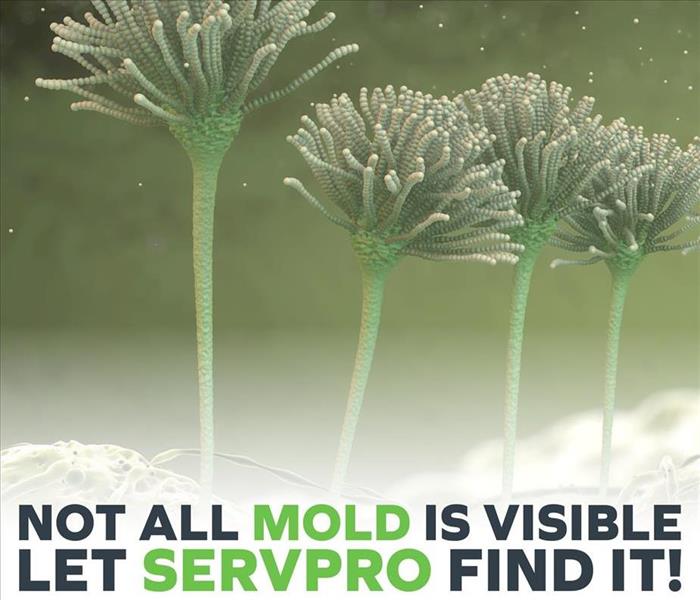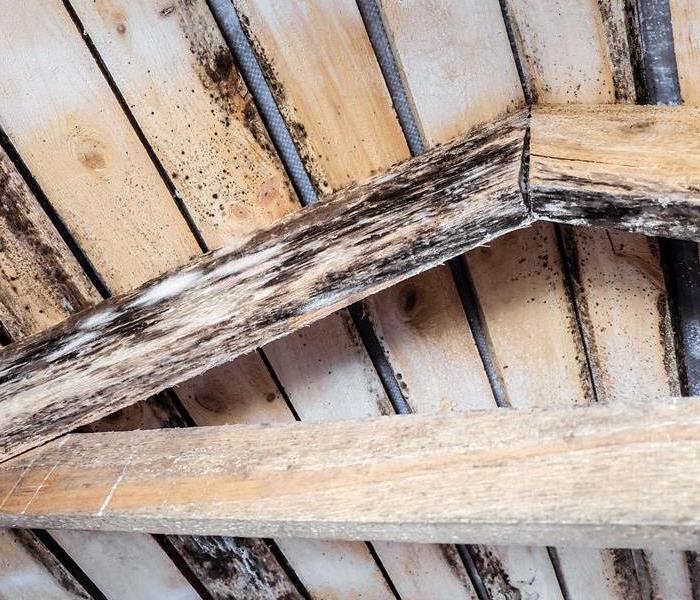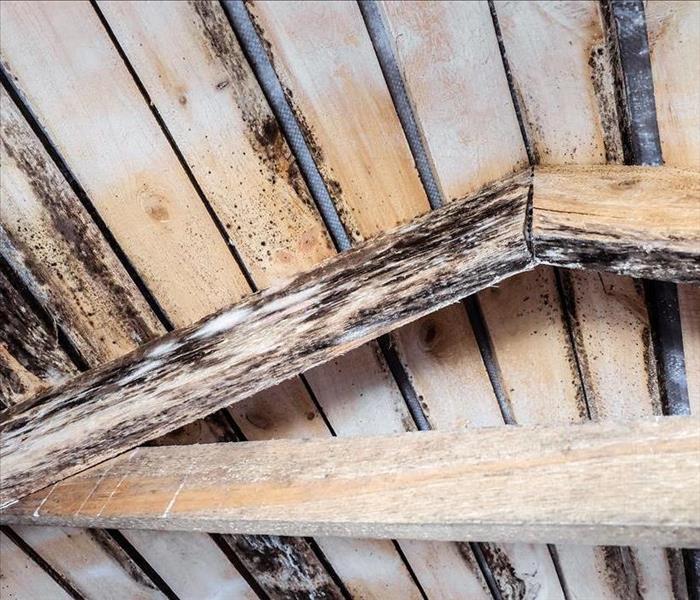Archived Mold Remediation Blog Posts
How to Prevent Mold in Household Plants
11/14/2024 (Permalink)
 Not all mold is visible
Not all mold is visible
Indoor plants add beauty, improve air quality, and bring life to our homes. However, mold growth in plant soil can be a common issue, especially in humid environments. Mold not only affects plant health but can also lead to an unpleasant odor and potential health concerns. Here’s how to prevent mold from developing in your household plants:
1. Avoid Overwatering
Overwatering is the most common cause of mold in plant soil. Excess water creates a damp environment perfect for mold growth. To prevent this:
- Check soil moisture: Only water your plants when the top inch of soil is dry. You can test this by sticking your finger into the soil.
- Drain excess water: Ensure pots have drainage holes, and empty saucers of standing water.
2. Improve Air Circulation
Poor air circulation can trap moisture and encourage mold. To improve airflow:
- Place plants in ventilated areas: Avoid putting them in closed, dark spaces.
- Use a fan: Running a small fan near your plants a few hours a day can help keep air moving and reduce humidity.
3. Adjust Humidity Levels
Mold thrives in humid conditions. If your indoor environment is humid, try the following:
- Use a dehumidifier: This can help reduce moisture in the air, especially if you have many plants or live in a naturally humid area.
- Avoid misting: While some plants benefit from misting, excess humidity around the leaves and soil can encourage mold.
4. Choose the Right Soil
Good soil quality helps prevent mold:
- Use well-draining soil: Soil with good drainage prevents water from lingering around plant roots.
- Avoid reusing old soil: Old soil can harbor mold spores, so always use fresh potting soil for new plants.
5. Add a Soil Topper
A layer of decorative stones or sand on top of the soil creates a barrier that inhibits mold growth:
- Add sand or small rocks: This helps keep the top of the soil dry, which discourages mold from forming.
6. Keep Plant Leaves Clean
Dust and debris can encourage mold growth, so clean your plant’s leaves regularly:
- Wipe down leaves: Use a damp cloth to remove dust, and make sure no water droplets remain afterward.
- Remove dead leaves: Regularly trim dead or decaying leaves, as these can create mold-friendly spots.
7. Give Plants Enough Sunlight
Sunlight helps dry the soil and prevent mold:
- Place plants in natural light: Position plants near windows or other light sources, and rotate them to get even exposure.
- Use grow lights: If your home doesn’t get enough natural sunlight, grow lights can help maintain healthy plant conditions.
8. Use Natural Fungicides If Needed
If you see early signs of mold, try these natural remedies:
- Cinnamon powder: Sprinkle a small amount on the soil’s surface; cinnamon has natural antifungal properties.
- Baking soda solution: Mix one teaspoon of baking soda with a quart of water, and spray lightly on the soil.
By following these simple tips, you can create a healthier environment for your plants and keep mold at bay. With the right balance of moisture, airflow, and sunlight, your household plants will thrive mold-free!
Mold Growth in Insulation: What to Do When It's Hidden
10/29/2023 (Permalink)
 Mold growth within insulation can be a threat to your home. Minimizing potential damage after a water loss
Mold growth within insulation can be a threat to your home. Minimizing potential damage after a water loss
Mold growth in insulation is a common but often overlooked issue. When mold is hidden within insulation, it can be challenging to detect and address. In this blog, we will explore what to do when faced with mold in insulation, without discussing associated health risks or concerns. By understanding the signs, prevention methods, and appropriate remediation techniques, homeowners can effectively manage mold growth within their insulation.
Signs of Mold in Insulation
Identifying mold growth within insulation can be tricky, as it often remains hidden from sight. However, there are a few indicators to watch out for. Musty odors emanating from the insulation may suggest mold presence. Discoloration, particularly dark spots or patches on the surface, can also be a sign. Peeling or damaged insulation may reveal mold growth underneath. Regular inspection and awareness of these signs can help homeowners detect mold in insulation early and prevent further damage.
Prevention Measures
Preventing mold growth in insulation starts with addressing moisture-related issues. Identify and fix any leaks or sources of water intrusion that can provide the ideal conditions for mold growth. Improve ventilation in areas where insulation is present to allow for the proper exchange of air and reduce humidity levels. Ensure proper installation of insulation, avoiding compressing the material, as trapped moisture can promote mold growth. Conduct regular inspections and maintenance to identify and address any potential moisture problems promptly.
Remediation Techniques
Remediation of mold in insulation should be undertaken cautiously to prevent the spread of spores. If the mold growth is minimal, homeowners can attempt to clean the surface using appropriate tools and cleaning solutions. Remove and replace any insulation that shows signs of extensive mold growth or damage. Disposal should be done safely, following local regulations. It is important to address the underlying moisture issue before replacing the insulation to prevent recurring mold problems. If the extent of mold growth is significant or if there are concerns about the cleanliness of the area, professional remediation may be necessary.
Hiring Professional Services
When dealing with mold in insulation, it is crucial to consider hiring professional services for a thorough and effective remediation process. Experienced mold remediation specialists have the necessary expertise, tools, and techniques to safely remove and replace affected insulation. They can conduct a comprehensive assessment to determine the extent of the mold growth, identify the source of moisture, and create a customized remediation plan. Professional services assure proper containment measures are implemented, preventing cross-contamination to other areas of the home. By entrusting the task to experts, homeowners can have peace of mind knowing that the mold issue in their insulation will be addressed efficiently and safely.
Mold growth within insulation can be a hidden threat to your home's integrity. By being mindful of the signs, implementing preventive measures, and taking appropriate remediation steps, homeowners can effectively manage mold growth in insulation. Early detection and prompt action are key to minimizing potential damage and maintaining a healthy living environment.
The Persistence of Mold: Why Does it Keep Coming Back?
5/15/2023 (Permalink)
 So why does mold keep coming back?
So why does mold keep coming back?
Mold is a common problem in many homes and buildings. Even if you clean it up and think it's gone for good, it can often return. So why does mold keep coming back? In this blog, we will explore the reasons why mold is so persistent and provide some tips on how to prevent it from returning.
Understanding Mold Growth
Before we can understand why mold keeps coming back, it's important to understand how mold grows. Mold is a type of fungus that thrives in warm, damp environments. It can grow on a variety of surfaces, including walls, ceilings, floors, and even furniture. Mold can cause serious damage to your home if left untreated, including structural damage and unpleasant odors.
Insufficient Cleaning
One reason why mold may keep coming back is insufficient cleaning. When you clean up mold, it's important to not only remove the visible growth but also the spores that can cause future growth. If you don't remove all the spores, the mold can easily regrow. In addition, if you don't address the underlying moisture problem that caused mold growth in the first place, it's likely that it will return.
Hidden Mold Growth
Another reason why mold may keep coming back is due to hidden mold growth. Mold can often grow behind walls, in ceilings, or under flooring, where it's not immediately visible. If you don't address the underlying moisture problem, the hidden mold can continue to grow and eventually become visible again.
Poor Ventilation
Poor ventilation is another common cause of mold growth. When there is insufficient ventilation in a room, moisture can build up and create an ideal environment for mold growth. This can occur in bathrooms, kitchens, and other areas of the home where moisture is often present. By ensuring proper ventilation, you can prevent mold growth and reduce the risk of it returning.
Moisture Problems
Moisture problems are one of the most common causes of mold growth. If you have a leaky roof, a plumbing leak, or poor drainage, it's likely that moisture is building up in your home and contributing to mold growth. By addressing the underlying moisture problem, you can prevent mold growth and reduce the risk of it returning.
Preventing Mold Growth
The best way to prevent mold growth and prevent it from returning is to control moisture levels in your home. This means fixing any leaks or water damage immediately, using a dehumidifier in damp areas, and ensuring that your home is well-ventilated. It's also important to clean up any spills or moisture promptly to prevent mold from growing.
In conclusion, mold can be persistent and difficult to get rid of if you don't address the underlying causes of its growth. By understanding the reasons why mold keeps coming back and taking steps to prevent it, you can keep your home healthy and mold-free. If you are struggling with mold growth in your home, it's important to contact a professional restoration company, like our SERVPRO of Ozone Park/Jamaica Bay team to help identify the underlying causes and develop a plan to prevent it from returning.





 24/7 Emergency Service
24/7 Emergency Service


